|
|
|
|
December 2020
 French cavalry with an aircraft overhead, 1916. World War I was a time of incredible technological innovation and so is its remembrance in the 21st Century.
|
|
Technology & WWI: Then and Now
“'The soldiers rode into World War I on horseback and rode out in tanks and airplanes,' is a popular quote about WWI. 'The War that Changed the World' was a driving force for incredible technology advancement and innovation. So it is only fitting that WWI’s remembrance should also be imbued with innovation," writes Theo Mayer, Chief Technologist of the United States World War One Centennial Commission and The Doughboy Foundation. Click here to take a look at the 21st century technologies now being used for the remembrance and commemoration of WWI, including Augmented Reality, Virtual Reality, podcasting, streaming, photogrammetry, 3D printing, and more.
Support the Doughboy Foundation
this giving season!

As you consider making donations this holiday season, we hope you will include the Doughboy Foundation in your year-end giving plans.
To give online, please visit the Doughboy Foundation web site here.
Checks may be made out to the Doughboy Foundation and mailed to:
The Doughboy Foundation
PO Box 17586
Arlington, VA 22216
Online gifts must be made by December 31st at 11:59pm EST and checks must be dated December 31 to receive 2020 tax credit.
With your support, we look forward to launching new initiatives in this next phase of the commemoration of and education about WWI in the new year.
|
Pershing’s Paths of Glory comes to life
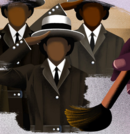
When Jerri Bell first wrote about the Golden Fourteen, their story only took up a sentence. These 14 Black women were the first to serve in the U.S. Navy, and Bell, a former naval officer and historian with the Veteran’s Writing Project, included them in a book about women’s contributions in every American war, co-written with a former Marine. But even after the book was published, Bell couldn’t get their story out of her head. “It made me kind of mad,” Bell says. “Here are these women, and they were the first! But I think there was also a general attitude at the time that the accomplishments of women were not a big deal. Women were not going to brag.” Click here to read more about how Bell was to track down the documents that acknowledge the lives and work of these Black Navy women in World War I.
|

A memorial in the courthouse square to Loudouners who died serving in World War I will be replaced with one that does not segregate those service members by race. The plaque, on a stone monument, lists 30 names. Three of those are at the bottom of the plaque, separated by a line—the three Black people on the list, Pvts. Ernest Gilbert, Valentine B. Johnson and Samuel C. Thornton. The memorial was erected 1921, three years after the war, donated by the American Legion. Click here to learn how the plaque will be replaced with a new one with all of the names listed together.
|
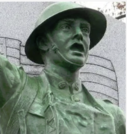
Over one year later, the Doughboy statue in Wheeling Park in Wheeling, WV is back, and near a century old, is looking better than ever after a restoration. Covered in dents, bird droppings, rust head to toe, a missing rifle and a hand poorly reattached...the elements were not kind to this 88-year-old figure, but Wheeling was. Click here to read more about how individuals and local foundations raised a whopping $21,000 to fix the Doughboy, a cost the friendly city deemed deserving as he stands to remind the Ohio Valley of all who fought for our freedom in World War I.
|

In this day and age when some want to take down statues from past generations and wars, Lynbrook has its own statue that has stood for 100 years, as of this past October. However, the statue did cause some controversy in the 1930s, with one newspaper saying it caused a “village civil war.” That statue is the veteran’s Doughboy Monument (also called the Soldiers and Sailors monument in the 1920s), a statue of a World War I soldier which stands on a small plot of an island in Saperstein Plaza behind Lynbrook’s Long Island Rail Road station. It is the centerpiece of the village’s war monuments. On the four-sided pedestal below the statue are the names of 15 local soldiers killed in action in World War I. Click here to read more about the many travels and final installation of the Doughboy.
|
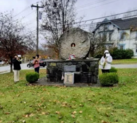
As many people celebrated Veterans Day in quiet ways on their own due to pandemic restrictions, Port Jervis, NY Mayor Kelly Decker and a small number of local musicians carried out a brief, socially distanced rededication at at the town's Skinners Park. In 1940, the 20-ton granite disc monument was “dedicated to the memory of the living and dead from WWI” This November’s rededication included the addition of a perpetual flame and a bronze plaque naming the 34 Port Jervis men who gave the ultimate sacrifice in the line of duty during World War I. Click here to read more about the history of the monument, and how the recent rededication ceremony took place.
|
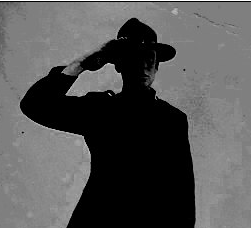
A man is only missing if he is forgotten.
For our MIA article this month, Doughboy MIA is going to take the opportunity to introduce you all to some of the changes coming to us and our program in 2021. Many of you will have received an email recently asking your basic level of interest in what it is we do. Your response was overwhelming and appreciated! It is heartening to know how much America still cares for her lost sons from the war that changed the world! As we move forward through this new year, expect to learn more about us and what we will be doing.
First off though, this month we would like to address the main questions we face in our work: why, and why now? The ‘why’ encompasses a complex answer. First, it’s about commemoration. Commemoration is our primary focus; It isn't all about recovery of remains, but it IS about making an accounting. First and foremost, we look at the cases and try to make a determination as to what happened to these men. We have technology that can cross match details - they had shoe boxes of index cards and paper files to sift through. Our #1 goal is to tell their stories and keep them from being forgotten, researching and recording these men and what happened to them. There is no full record of them and this is a travesty that has stood for too long. No more will these men be forgotten if we can help it – and we will. As our motto states: a man is only missing if he is forgotten.
Our secondary mission is attempted recovery of remains, if the situation appears possible. Today we have technology available to us that make the search beyond anything they could have dreamed of following the war. With that in mind the question of ‘why’ then begs the answer ‘why not’?
Yet the biggest reason for making any attempt at bringing them home boils down to one main reason really. America made a promise to her soldiers and families in 1917: she would bring everyone home. This was America's first major overseas operation. For the very first time we were going to send a major force to fight on foreign shores and there were many in the public with grave concerns about our involvement in what was generally considered a 'European affair'. To that end, America assured the public that she would care for her soldiers properly - dead or alive, we would all come home. However, following the war the number and type of casualties we would incur in France and Belgium posed the US with the herculean task of caring for 116,000 dead in just 19 months; 56,000 of these in combat. Public opinion had shifted as well, with a little over half of the families (59%) wanting their loved one brought home and the rest believing it was right to leave them in France beside their comrades. In the end, of the 75,000 burials in France only 31,000 would stay.
This included MIA's. Between 1919 and 1932 the GRS went to extraordinary lengths to find the missing (most of whom were buried in battlefield graves that were just never located; contrary to popular belief most were not 'blown to bits by shell fire') and identify the recovered remains that went as unknown. Their efforts were truly heroic and ongoing, exhausting every avenue available at the time. Beginning in 1932 the GRS took one last look at each and every file of a missing serviceman, making one final attempt for them before systematically closing the files. By 1934 all the files were closed, the cemeteries overseas were closed to further interment, and all search efforts were suspended. They had done all they could to keep the promise. The names of the missing were commemorated on the Tablets to the Missing at each of the US cemeteries overseas as a permanent memorial.
Since then a few sets of remains have turned up over the years and the military did what was proper for these men. It must be remembered: they are still United States service personnel and thus the responsibility of the US military. To that end the military still has a responsibility to them and a promise to keep to their families. Many families were devastated by the loss of their loved one, particularly as they were never 'found'. Time and again we at Doughboy MIA talk to current relatives that know the family history - that the loss left a hole in the family felt to this day. To that end, Doughboy MIA remains aware of the responsibility of America to these families. These men deserve a named grave for the simple fact they lost their lives in the service of their country and were promised we wouldn't leave them behind. Again, if they had had access to the tech back then that we do now, we wouldn't be having this conversation. The passing of the years does not eliminate the responsibility we have to these soldiers and their families.
That brings us to the ‘why now’? Basically it’s because this is very likely the last window of opportunity there will be. The tech is here now; that is what drew us to the possibility of recovery. But hand in hand with that is the fact that in another 20-30 years any remains recovered will likely be far too degraded for a positive DNA sampling, despite advances in tech. Further, by then yet another generation will have gone by. As each generation comes and goes, the legal line of DNA in a family stretches and thins. In another generation of two we won't be able to successfully gain a legal DNA sample from a bloodline. Thus, this window of opportunity we currently face today is likely the last opportunity for these men, and that window is closing. What kind of country would we be if we had that last opportunity and let it go by?
You can help too. YOU can be a part of the solution with us. Simply consider making a tax-deductible donation to our non-profit organization and help make it possible to keep these men alive. Visit www.ww1cc.org/mia today to make your donation. You may also sign up there to get more information on other ways you may be able to help.
Above all remember: a man is only missing if he is forgotten.
Join us in helping keep them from ever being forgotten again.
|
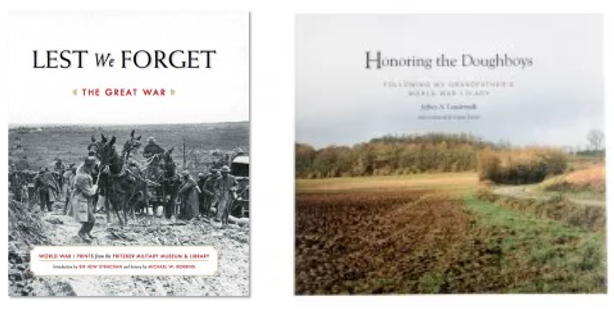 Lest We Forget: The Great War World War I Prints from the Pritzker Military Museum & Library. One of the nation’s premier military history institutions pays tribute to the Americans who served and the allies they fought beside to defeat a resourceful enemy with a lavishly illustrated book. It is an official product of the United States World War One Centennial Commission and is a tribute to those who served in the Army, Navy, Marine Corps, and what would become the Air Force. It serves as a lasting reminder that our world ignores the history of World War I (and the ensuing WWII) at its peril―lest we forget.
Honoring the Doughboys: Following My Grandfather's World War I Diary is a stunning presentation of contemporary photographs taken by the author that are paired with diary entries written by his grandfather, George A. Carlson, who was a soldier in the U.S. Army during World War I. Jeff Lowdermilk followed his grandfather's path through France, Belgium, Luxembourg, and Germany and returned with these meticulously crafted photographs and his own engaging stories that bring the diary to life for contemporary readers. Lowdermilk's passion for World War I and military history began as a young boy when he listened to his grandfather tell his stories about serving as an infantryman-- a "Doughboy"--in Europe during the Great War.
Proceeds from the sale of these books will help build the new National World War I Memorial in Washington, DC.
This and many other items are available as Official Merchandise of the United States World War One Centennial.
|
|
|
|
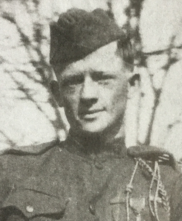
Submitted by: Diana Quinn Cotton {Granddaughter}
Henry Eugene Quinn born around 1899. Henry Quinn served in World War 1 with the United States Army. The enlistment was in 1917 and the service was completed in 1919.
Story of Service, Addendum, & Personal Notes
PFC Henry E. Quinn served as a company runner in Co. F 28th Infantry 1st Division, American Expeditionary Forces, United States Army, during World War I and was awarded the Distinguished Service Cross, Silver Star, Purple Heart with Oak Leaf Cluster, Croix de Guerre, and Victory Medal with Five Battle Clasps.
My grandfather, Henry Eugene Quinn, was born in Anniston, Alabama, on January 31, 1899. He was the fourth of eleven children of William Eugene Quinn (1865-1945) and Emma Langdon (Fowler) Quinn (1873-1963). He stood 5’ 8” tall, had red hair, blue eyes, a fair complexion, and was covered in freckles. His nicknames were “Bud” (at home) and “Red” (in the Army).
In his World War I memoirs, written many years after the war, Henry wrote:
“March 1917—Applied for enlistment at Monroe (LA), was examined by a colonel Dr. who was rather rough in criticizing my physical condition, stated that I looked like a picked chicken, etc., account of being so skinny. I was not use to such criticism & talked rather rough to him in return. Sgt. was in the background motioning me to hush, etc., but I said my say. Col. flared up & stated, ‘He will do Sgt—I will get a waver on his weight tonight.’ I was 11 lbs. under weight.”
Henry briefly returned to Swartz, LA, to inform his family he had joined the Army and to tell them goodbye. His father “shook hands & told me that I had been my own boss for some time, but now I had a real boss.”
|

|
|
|
|